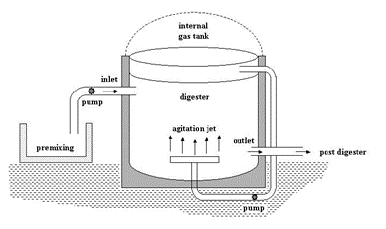Biogas Technology
“
— ”
Livestock farming is South Africa's largest agricultural sector, accounting for over 40% of agricultural output's total value and occupying roughly 80% of available agricultural land.1 Therefore, it is endowed with plenty of biomass reserves and can be a candidate solution to animal waste, which is still a growing problem.
Biogas is a gas that is produced when any organic matter decomposes under anaerobic conditions. The methane from biogas (bio-methane) is a source of renewable energy producing electricity, and can be a solution to South Africa’s current energy problems2, due to its strong reliance on coal and fossil fuel energy. As opposed to wind and solar energies, biogas can be stored and used based on timely needs, making it the efficient choice especially in South-Africa.
An interesting example is the Bio2Watt Bronkhorstspruit plant, which is the first industrial scale biogas waste-to-energy operation in South Africa, starting 2015. BMW factory in Rosslyn plant, Pretoria, opened in 20183 and uses 30% electricity from Bio2Watt renewable energy.
In 2016 there were 200 digesters all through SA, in which 90% of them are small scale users. SA is lagging behind, mainly due to high initial investment costs, inconsistency of substrate to feed into digesters and lack of funding for education and dissemination programs, to name a few.

Image source:
Schematic diagram of biogas plant
References
1. https://www.businesswire.com/news/home/20210308005418/en/Farming-of-Animals-in-South-Africa-2020-Market-Report---ResearchAndMarkets.com
2. Mukumba, Patrick & Makaka, Golden & Mamphweli, Ntshengedzeni. “Biogas Technology in South Africa, Problems, Challenges and Solutions”. International Journal of Sustainable Energy and Environmental Research. 2016
3. Rangongo, Timothy. “This is what it looks like inside the massive Pretoria BMW factory, which produces 15 luxury SUVs per hour”. Business Insider SA. September 10th, 2018.
1. https://www.businesswire.com/news/home/20210308005418/en/Farming-of-Animals-in-South-Africa-2020-Market-Report---ResearchAndMarkets.com
2. Mukumba, Patrick & Makaka, Golden & Mamphweli, Ntshengedzeni. “Biogas Technology in South Africa, Problems, Challenges and Solutions”. International Journal of Sustainable Energy and Environmental Research. 2016
3. Rangongo, Timothy. “This is what it looks like inside the massive Pretoria BMW factory, which produces 15 luxury SUVs per hour”. Business Insider SA. September 10th, 2018.